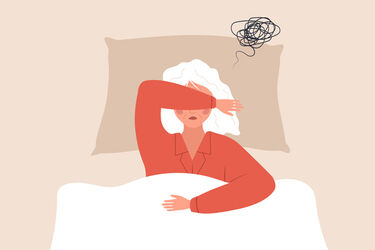We ask experts working in Jean Hailes Clinics to answer questions you have about cases you see in your work and/or clinical practice, covering women’s health topics such as menopause, contraception, vulval disorders, pelvic pain, pelvic floor issues, incontinence, PCOS, endometriosis, menopausal hormone therapy (MHT), health checks, mental health and more, across every life stage.
Women’s health specialists working at Jean Hailes Clinics include general practitioners, gynaecologists, physiotherapists, endocrinologists, a naturopath, urogynaecologists, psychologists and dermatologists.
Content on this page is intended only for health professionals.

Question answered by Jean Hailes Endocrinologist Dr Sonia Davison.
Question answered by Jean Hailes Endocrinologist Dr Sonia Davison (pictured).

Question answered by Jean Hailes Endocrinologist Dr Sonia Davison.

Question answered by Jean Hailes Endocrinologist Dr Sonia Davison.
Question answered by Jean Hailes Endocrinologist Dr Sonia Davison (pictured).

Question answered by Jean Hailes Endocrinologist Dr Sonia Davison.

Question answered by Jean Hailes Medical Director and Gynaecologist Dr Elizabeth Farrell AM (pictured).

(To read answers, toggle the orange + button next to the questions below or click here)
A: From health psychologist and CEO of the Sleep Health Foundation Dr Moira Junge
Even though your patient denies snoring and reports sleeping all night, I would be highly suspicious of undiagnosed obstructive sleep apnoea (OSA). We often associate OSA with overweight men yet once a woman hits menopause the risks are similar, and if they sleep alone they won’t be aware of their snoring or any restlessness at night.
I would suggest a referral to a Respiratory and Sleep Disorders Physician for an overnight sleep study and most likely she’ll need a trial of Continuous Positive Airways Pressure (CPAP) or a mandibular advancement splint.
If she is resistant to CPAP therapy there are many psychologists and CPAP therapists, often attached to the major sleep centres at hospital, that can provide some evidence-based support for CPAP adherence and help with the often tricky transition to having to wear a mask and machine at night during sleep.
A: From health psychologist and CEO of the Sleep Health Foundation Dr Moira Junge
Thanks for your question, as you’re aware sleep can be really challenging in the menopausal and perimenopausal years. I would recommend your patient accesses CBTi via telehealth from one of many practitioners around Australia who have expertise in sleep, check out all the major sleep centres across the nation.
Some of the elements of CBTi can be done in the medical setting, in as little as 15-minute appointments. See this helpful link for some tips and hints: RACGP - Brief behavioural therapy: insomnia in adults. No matter what caused the sleep difficulty, even hormonal changes, sometimes it’s similar issues such as worry and maladaptive habits that keep the sleep issues going longer than they should. Unfortunately, there is no current register or list of CBTi practitioners in Australia but we’re working on it. The Sleep Health Foundation website also has some helpful fact sheets, see these two on Menopause and CBTi.
Often by addressing the concerns about the lack of sleep, the sleep can improve enough to no longer be debilitating however if she’s having severe night sweats and the like then it’s worth addressing the hormonal disturbance.
By the way re MHT and HRT, both terms are acceptable but I know here at Jean Hailes for Women’s Health that MHT is now the preferred term. It could be helpful to spend some time asking why she’s so opposed to MHT, it’s possibly worth hearing her concerns and educating her about the benefits and spending some time answering her questions about the risk (which might be based on incorrect or outdated information). This can really open up the possibilities of a trial of some medical options for her hormonal changes.

(To read answers, toggle the orange + button next to the questions below or click here)
A: from Jean Hailes Medical Director and gynaecologist, Dr Elizabeth Farrell AM.
If your patient aged 60 is symptomatic and between 50-60 years or within 10 years of menopause, it is safe for her to use MHT. Your prescribed doses are appropriate. Some women require higher oestrogen doses for symptom relief.
With the 75mcg patch, add Prometrium 100mg 2 tablets nightly or “off label” use Prometrium 100mg vaginally at night. Both the patch and Prometrium are bioidentical hormones. Compounded hormones are not recommended.
A: from Jean Hailes Medical Director and gynaecologist, Dr Elizabeth Farrell AM.
No, an ultrasound or a progesterone challenge are unnecessary if the vaginal product is used according to the recommended dose regimen, as the amount of oestrogen absorbed into the general circulation is very small. We recommend placing the oestrogen preparation into the lower third of the vagina as the blood supply is different from the upper two-thirds, and supplies the lower vagina, base of bladder, the urethra and vulva.
A: from Jean Hailes Medical Director and gynaecologist, Dr Elizabeth Farrell AM.
Prometrium vaginally in MHT is “off label” use and is not recommended or registered by the pharmaceutical company nor the Australasian Menopause Society as there is no supporting literature in MHT.
It is available in a vaginal tablet for IVF with satisfactory absorption and endometrial protection. It is thought 100mg vaginally is equivalent to 200mg orally.
(To read answers, toggle the orange + button next to the questions below or click here)
A: from endocrinologist, Dr Sonia Davison
I am assuming this patient has had a negative thrombophilia screen and that there is evidence that the pulmonary embolus has resolved and there is no residual clot evident.
It’s interesting that her menopausal symptoms were controlled on Slinda; this is a progestogen only contraceptive product that is not intended as a menopausal hormone therapy, and it would be unusual that this medication on its own would be useful for menopausal symptom control.
With that in mind I suspect her symptoms could be controlled via other measures. My tendency would be to pursue non-hormonal medications for symptom control.
Here is a podcast on this topic from our website and an excellent information sheet from the Australasian Menopause Society website.
The medication options include any of an SNRI, an SSRI, gabapentin or clonidine. Cognitive behavioural therapy or hypnotherapy may also be useful. If she remains anticoagulated and if her haematologist is happy with the plan, she could possibly have a trial of transdermal combined oestradiol/ norethisterone acetate patch. However bleeding may be an issue, given she is anticoagulated.
A: from endocrinologist, Dr Sonia Davison
The evidence shows that there is no increase in venous clot risk associated with transdermal hormone therapy, and amongst progestogens, the VTE risk associated with micronized progesterone is low. Hence if hormone therapy is being considered for bothersome menopausal symptoms, a transdermal approach would be recommended.
My advice would be for this woman to consult a haematologist for general advice about the general VTE risks associated with having antiphospholipid antibodies, and particularly in regard to menopausal hormone therapy use.
Non-hormonal medications (see question above), cognitive behavioural therapy or hypnotherapy may all be useful strategies to reduce symptoms, and hence avoid an increase in VTE risk.
Here is an excellent information sheet from APS Support UK.
For further reading, see the following links:
A: from endocrinologist, Dr Sonia Davison
See more detail in answers above.
There is no evidence that shows an increase in VTE risk on transdermal menopausal hormone therapy. As the Mirena is providing the endometrium with adequate progestogen this patient only needs the addition of oestrogen. An oestradiol patch or gel could be used, starting with low dose. I always refer these patients to a haematologist, to advise about VTE risk and management in the setting of future travel/ surgery/ potential menopausal hormone therapy use, and how to advise family members.
Other options for her may include any of the SSRI group, gabapentin, oxybutynin or non-medication options such as cognitive behavioural therapy or hypnotherapy.

(To read answers, toggle the orange + button next to the questions below or click here)
A: from Jean Hailes Medical Director and gynaecologist, Dr Elizabeth Farrell
Thank you for your question. It is of concern that patients are being prescribed oestrogen alone when they still have a uterus.
Sometimes the reasons for being on combined oestrogen and progestogen are not explained clearly to the patient so she may cease the progestogen if there are unpleasant side effects, thinking it is safe to do so.
There are two pathways: initially cycle her progestogen for three months to have a withdrawal bleed then continue with continuous therapy, or initially perform an ultrasound to check the endometrial thickness which, if less than 4mm, start continuous progestogen. If the endometrium is greater than 4mm, then cycle the progestogen for three months and recheck endometrial thickness. Always recommend the ultrasound be performed immediately postmenstrual when the endometrium is thin.
A: from Jean Hailes Medical Director and gynaecologist, Dr Elizabeth Farrell
If endometriosis has been proven by laparoscopy, then postoperative management is by hormonal suppression to treat symptoms of pain and suppress growth of endometriosis cells that may still be present.
The aim is to reduce the risk of recurrence, or delay recurrence.
In some cases, ovulation also needs suppression as well as endometrial thinning, requiring both an oral contraceptive and a Mirena™ IUS. If adenomyosis is also present, the use of the Mirena™ IUS will suppress the adenomyotic cells.
If the individual’s symptoms are controlled, then these treatments should continue unless the individual wishes to become pregnant or have a trial off the hormones. It is most likely that if you discontinue the treatment, symptoms may return, and a recurrence may occur earlier.
Working with the individual’s gynaecologist will assist in providing optimum treatment for your patient.

(To read answers, toggle the orange + button next to the questions below or click here)
A: from endocrinologist, Dr Sonia Davison
Meningiomas occur in around 5 in 100,000 people, and are two to three times more common in women, compared with men. They are mostly benign in nature but have been found to have hormone receptors present within the cellular tissue.
Around 70% express progesterone receptors, and less than 30% express oestrogen receptors. Meningiomas may also increase in size during pregnancy. Hence the question has been asked whether there is a relationship between meningioma and hormones in women.
What studies have shown is that there seems to be a slight increase in risk of meningioma in women who have used menopausal hormone therapy (MHT). However, there isn't a lot of research into the effects of hormone therapy on an existing meningioma. The literature points in the direction of avoiding hormone therapy in the presence of a known meningioma.
I suspect the best person to answer this question is the treating neurosurgeon, but an endocrinologist or other women's health expert may be able to give guidance as to what other treatments may be useful for the treatment of bothersome menopausal symptoms, if hormone therapy is to be avoided.
A: from endocrinologist, Dr Sonia Davison
My approach for women with inherited thrombophilia is for them to see a haematologist, for several reasons, even if there is no history of VTE and if they are a carrier of a thrombophilia mutation. To discuss their own risks for VTE, given their age, their general health and other VTE risk factors, but also to talk about the need for screening other family members (for example children). Also it’s important to discuss advice about travel, what to do in the event of pregnancy or planned surgery, and also for discussions about use of hormonal contraception or menopausal hormone therapy (MHT).
Transdermal MHT has not been associated with an increase in VTE risk in research studies, and the combination of micronised progesterone and transdermal oestradiol has been associated with a very low VTE risk, as has Tibolone.
Low-dose MHT is also associated with a lower risk of VTE compared with higher doses.
However, for safety reasons I will refer these women to a haematologist, and if the woman has menopausal symptoms and is considering MHT use, I will be asking the haematologist to comment about VTE risks associated with MHT in addition to the other issues outlined above.

(To read answers, toggle the orange + button next to the questions below or click here)
A: from endocrinologist Dr Sonia Davison
Tachyphylaxis occurs when a woman requires progressively higher oestrogen doses to achieve the same symptom control; it sounds like this is happening in your patient. I am worried about her exposure to high dose oestrogen in terms of breast cancer risk and endometrial protection, amongst other issues.
While some women do not absorb transdermal oestrogen well, her doses of oestrogen have been excessive and potentially have put her at risk.
I worry about endometrial protection on her current MHT and would favour a levonorgestrel IUD as the progestogen, in someone who is using a 100ug oestradiol patch. There is no mention of vasomotor symptoms hence I worry that the brain fog is due to her insomnia and that menopause may not actually be the key driver of her symptoms.
I assume you have done a general screen to check for other causes of her symptoms (such as checking thyroid function and iron studies etc).
I would aim to tackle sleep via non-hormonal means, which could include any of cognitive behavioural therapy, hypnotherapy or medications. A sleep physician may be useful in this regard. I would ensure that her breast imaging was up to date and get a good quality transvaginal ultrasound to measure endometrial thickness.
A: from Jean Hailes Medical Director and gynaecologist, Dr Elizabeth Farrell AM
There are studies looking at the safety and efficacy of the LNG IUD with oestrogen replacement up to the age of 60 years. It provides good endometrial protection and amenorrhoea and is very cost-effective.
The LNG IUD is more commonly used in the perimenopause and subsequently in the post-menopause, because of its multiple roles of contraception, control of heavy menstrual bleeding and as a progestogen with oestrogen in MHT.
In postmenopausal women with persistent breakthrough bleeding on MHT without significant pathology, it is also an option to use the LNG IUD for bleeding control.
These two references are freely accessible and outline the studies performed:
Breast cancer risk increases in women on MHT with increasing dose and duration dependent as well as the type of progestogen. A study published in 2020 of two nested case-control studies showed the risk was lowest with dydrogestrone (and therefore progesterone) with increased risk on norethisterone, medroxyprogesterone acetate and levonorgestrel. The risk also increased with age and duration of therapy.
With your patient it would be appropriate to try the Mirena IUD for endometrial protection. I would then explain that in the longer term, breast cancer risk is lower with oral micronised progesterone than levonorgestrel.

(To read answers, toggle the orange + button next to the questions below or click here)
A: from Jean Hailes Medical Director and gynaecologist, Dr Elizabeth Farrell AM
This is a very important question as women with subtotal hysterectomy are often dismissed as having had a hysterectomy, therefore assumed a total hysterectomy.
I have been unable to source any studies outlining the recommendations on the use of MHT following subtotal hysterectomy.
Many gynaecologists may diathermy the cervical canal to reduce the incidence of endometrial cells remaining at the time of the surgery but that is not a guarantee that all cells have been removed.
Because of the possibility of remaining endometrial cells in the cervical stump, combined therapy is suggested.
There are two suggestions for the longer term:
Asking your patient to have an ultrasound, if possible with a gynaecologist-run service, to measure the cervical stump and assess for any endometrial tissue, may also help in decision making.
Many thanks for this interesting and important question.
A: from endocrinologist Dr Sonia Davison
As a kindness I usually advise patients to very slowly wean hormone therapy, with a gradual reduction in dose, as clinically this can result in less rebound in vasomotor symptoms. However, the research suggests there is no difference between gradual reductions in dose, versus going ‘cold turkey’.
Women are very individual in their menopausal symptoms and in their response to coming off hormone therapy, so there are no ‘set’ answers, unfortunately.

(To read answers, toggle the orange + button next to the questions below or click here)
A: from endocrinologist, Dr Sonia Davison
The high breast density and long-term hormone therapy both increase her breast cancer risk. Any additional risk factors such as family history of breast cancer would further increase her risk.
My preference would be to try to wean and cease the hormone therapy and opt for a non-hormonal medication for control of vasomotor symptoms (SSRI / SNRI / gabapentin or clonidine).
Cognitive behavioural therapy or hypnotherapy may also be useful.
A: from endocrinologist, Dr Sonia Davison
If she does carry Fragile X then this may explain the early menopause. Her daughter is at risk of undergoing a much earlier menopause if she is also a carrier. Hence in such cases, I usually do an autoimmune screen and also a Fragile X test.
If Fragile X carriage is confirmed, disclosure to other family members is strongly encouraged as it has potential implications for their health and that of their children.

(To read answers, toggle the orange + button next to the question below or click here)
A: from Jean Hailes Medical Director and gynaecologist, Dr Elizabeth Farrell AM
If your 29-year-old patient has had one smear result with HPV non 16/18 +ve with negative cytology in the present of endocervical cells and no other abnormality then the CST co-test is repeated in 12 months.
If there is any concern re abnormal bleeding then referral to a gynaecologist with a prior vaginal ultrasound would be appropriate.
If the candida infection is treated satisfactorily there is no indication for referral. However if her candida was recurrent and not responding to treatment adequately then referral to a vulval specialist, either gynaecologist, dermatologist or GP with special interest, would be indicated.
A: from Jean Hailes Medical Director and gynaecologist, Dr Elizabeth Farrell AM
POI is treated with high dose therapy usually the equivalent of Oestradiol 75 ug patch or greater with the corresponding progestogen until around the age of expected menopause. There are a number of possibilities all of which DO NOT have data, with increasing dose of oestrogens requiring increased progestogen.
Increase the dosages by having:
1. 2x patches Estalis™ continuous patches
It may be better to use Estalis continuous 50/250™. Place them side by side and change at usual time of every 3½ days. You could try ringing for an authority for the increased quantity of patches.
OR
2. Estradiol patches 75 –100 ug patches or estradiol gels + oral progestogen.
Ideally oral progesterone would be prescribed however there is no data on higher doses or being used vaginally. Using 200 mg orally nightly may be sufficient but is expensive for some women. It is used vaginally in IVF satisfactorily. However, it is used “off label“ vaginally in menopause women using 100 mg vaginally at night for the higher doses of oestrogen but experts not are all in agreement to recommend it because of the lack of data.
Norethisterone acetate or medroxyprogesterone acetate could be used but we are tending to prescribe less because of their small increase in breast cancer risk and possible VTE risk.
Monitor for both side effects, breakthrough bleeding and check endometrial thickness after the first 6 months on the regimen to establish the appropriate endometrial suppression by the progestogen.
The greying of her pubic hair may represent years without oestrogen or may be genetic.

(To read answers, toggle the orange + button next to the question below or click here)
A: from Jean Hailes Medical Director and gynaecologist, Dr Elizabeth Farrell AM
The issues your patient has is that she has flushing and sweating in the perimenopause but I assume is still menstruating as she is on the POP. The dose of POPs are usually very low and are not considered sufficient for standard doses of oestradiol e.g. oestradiol patch 50ug or oestradiol 2mg oral tablet. By topical HRT I assume you mean either transdermal patches or gels.
This woman obviously requires contraception so consider a Levonorgestrel IUD with the oestrogen. I would also exclude thyroid disease in this woman prior to commencing her on hormone therapy.
Vaginal or local/topical oestrogens for vaginal symptoms do not require progestogens.

(To read answers, toggle the orange + button next to the questions below or click here)
A: from Jean Hailes Medical Director and gynaecologist, Dr Elizabeth Farrell AM
Prometrium is micronised oral progesterone which is available in a 100mg capsule taken at night because of its somnolent properties. The product is registered as an oral preparation for menopause but there is a vaginal preparation available for IVF.
Using oral progesterone in the vagina is therefore "off label" usage and may equate to about double the oral dose. If the woman has side effects orally she may still have side effects with vaginal use.
The dose of Prometrium will depend on the dose of oestrogen used. A dose of oestradiol 50 micrograms patch then the usual daily oral dose of 100mg Prometrium nightly could be trialled every alternating night or three times per week vaginally. It is important to remember that this is "off label" usage.
References:
A: from Jean Hailes Medical Director and gynaecologist, Dr Elizabeth Farrell AM
The role of menopausal hormone therapy (MHT) is to treat menopause symptoms (oestrogen) but at the same time to protect the endometrium (progesterone). With hysterectomy, the uterus is removed and therefore the woman has no remaining endometrium. Oestrogen alone is needed.
The only exception is in a woman with severe endometriosis who has had a hysterectomy with or without bilateral salpingo-oophorectomy and has menopausal symptoms. In these women a progestogen or progesterone with the oestrogen is appropriate.
Your patient who is on Estradot 25 micrograms patch and has had a hysterectomy, does not need progesterone.

(To read answers, toggle the orange + button next to the questions below or click here)
A: from endocrinologist, Dr Sonia Davison
This information page on Tibolone on the Australasian Menopause Society website goes through the benefits and risks of Tibolone in detail.
There is a slightly higher risk of stroke from the 60s, and an increased risk of breast cancer that increases with duration of use. My preference would be to try a non-hormonal treatment for controlling the flushes (see this information page), and trying to avoid a return to hormone therapy if possible.
A: from endocrinologist, Dr Sonia Davison
Please also refer to the answer and resources for Q2 on the October edition of Ask an Expert: Q&A below.
The probability of pregnancy is very slim but not zero. She still has the options of barrier contraception, vasectomy and tubal ligation if she doesn’t want to pursue a levonorgestrel IUD for contraception, whilst on combined MHT (of any type). My preference would be to combine any form of oestradiol with the levonorgestrel IUD in this situation; the risk of bleeding is minimised, contraception is provided, and the ‘set and forget’ convenience of the IUD means that there will be less worry for all concerned.

(To read answers, toggle the orange + button next to the questions below or click here)
A: from endocrinologist, Dr Sonia Davison
There haven’t been any prospective studies directly comparing the breast cancer risk associated with Tibolone compared with body-identical combined menopausal hormone therapy (MHT). The only information we have is from cohort studies. A meta-analysis of cohort studies in The Lancet in 2019 reported on breast cancer risk with various forms of MHT. (Collaborative Group on Hormonal Factors in Breast Cancer. Type and timing of menopausal hormone therapy and breast cancer risk: individual participant meta-analysis of the worldwide epidemiological evidence. Lancet. 2019; 394:1159-68.) This meta-analysis reported that the breast cancer risk with Tibolone is lower than combined oestrogen and synthetic progestogenic MHT.
That paper also included very small numbers of women on body-identical MHT, and there was no statistically significant increase in breast cancer risk over 5 years, but there was beyond this timeframe. The direct answer to your question is that no-one really knows the exact answer! However, there are some excellent information sheets that may help on the Australasian Menopause Society website: Risks and benefits of menopausal hormone therapy; and Tibolone as menopausal hormone therapy.
A: from endocrinologist, Dr Sonia Davison
I suspect that the warning comes up due to a combination of the patient’s age in the setting of prior VTE. Drospirenone progesterone-only pill (POP) is designed for, and has been tested in the reproductive age group, and its contraceptive use is recommended in that age group, although guidelines state that POPs can be used until age 55 years. There is some excellent information about other types of contraception on our website, including a health professional webinar that was conducted with colleagues from Family Planning Victoria, in 2021.
The Australasian Menopause Society has an excellent information page with a focus on women of perimenopausal or menopausal age.

(To read answers, toggle the orange + button next to the questions below or click here)
A: from dermatologist, Dr Tanja Bohl
I think what you have done is good. Please consider the following:
The following things are for comfort and avoiding aggravating the vulva rather than specific treatment.

(To read answers, toggle the orange + button next to the questions below or click here)
A: from endocrinologist, Dr Sonia Davison
An expert speaking on this topic at a previous World Congress on the Menopause in Vancouver discussed that a family history of breast cancer is not necessarily a reason to avoid hormone therapy use. The issue is one of risk. If there are other risk factors, such as dense breasts, or multiple close relatives with breast cancer, or BRCA1/2 gene mutations present (etc), breast cancer risk increases.
The Australasian Menopause Society has an information sheet dedicated to risks and benefits of MHT (menopausal hormone therapy), which details these risks further. There are also online tools for women to assess their overall breast cancer risk (even in the absence of MHT use).
The studies to date suggest that MHT regimens associated with the lowest risk of breast cancer contain progestogens that are close to endogenous progesterone (dydrogesterone and micronised progesterone).
A: from endocrinologist, Dr Sonia Davison
Past venous thromboembolism (VTE) is no contraindication to vaginal oestrogen use, as there is very little systemic hormone absorption. The pessary or cream are used nightly, vaginally, for 2 weeks, and then twice weekly thereafter.
A: from endocrinologist, Dr Sonia Davison
Whenever the uterus is present and hormone therapy is used, there is a risk of bleeding. Young women who have recently had periods are more likely to have bleeding when hormone therapy is introduced, even if the regimen is continuous combined MHT. It is also common to have bleeding within the first three months of hormone therapy use. If bleeding continues after three months of use, it is worthwhile changing to sequential progestogen use to plan for a regular withdrawal bleed.

(To read answers, toggle the orange + button next to the questions below or click here)
A: from Jean Hailes Medical Director and gynaecologist, Dr Elizabeth Farrell AM
The vaginal oestrogen preparations that are available in Australia are low dose and do not appear to stimulate the endometrium.
There is some initial absorption of the oestrogen into the circulation when the vaginal epithelium is thin but this reduces to almost zero after some days once the epithelium thickens and, if used in an appropriate regimen as recommended, it can be used long term without the use of intermittent progesterone.
The data on Vagifem low™ 10ug vaginal tablets shows absorption of 1.14 mg oestradiol over a 12month period.
A: from Jean Hailes Medical Director and gynaecologist, Dr Elizabeth Farrell AM
There is very little data on epilepsy and MHT. The use of oral MHT has been studied but only in the short term and with small numbers. A study using Premarin™ and Provera™ appeared to increase seizures.
It is thought that transdermal oestrogen and oral progesterone is probably the most suitable in women who are unresponsive to nonhormonal therapies.
A: from Jean Hailes Medical Director and gynaecologist, Dr Elizabeth Farrell AM
As there is evidence of vulvo-vaginal atrophy on examination and a discharge visible, I would first take a vaginal swab for micro and culture to exclude any bacteria or candida. I would also ask about sexual partners and if she has had a sexual health check.
I assume she has had a hysterectomy as you do not mention a progestogen.
Is it possible she has vulvodynia and the use of amitriptyline may be of benefit? She does get relief using Vaseline so continuing with that and reviewing her in a few weeks is an alternative.
If you have excluded any urethral, bladder, vulva or vaginal lesion or prolapse and your diagnosis is vaginal atrophy then the use of vaginal oestrogen would be appropriate as it will have a positive effect on the urethra and bladder base reducing her risk of recurrent urinary tract infections and hopefully her introital symptoms.

(To read answers, toggle the orange + button next to the questions below or click here)
A: from Jean Hailes Medical Director and gynaecologist, Dr Elizabeth Farrell AM
The vaginal microbiome (VMB) changes throughout life from birth, prepuberty, then to the reproductive years and lastly in the postmenopause. The postmenopause VMB is similar to the prepuberty stage with thin vaginal epithelium, an alkaline environment, low glycogen and lactobacilli growth. This picture is the result of low oestrogen.
Circulating oestrogen during the reproductive years and in the presence of systemic or vaginal oestrogen therapy in the postmenopause leads to increase in the vaginal epithelium and mucosal layer thickness with glycogen production and lactobacilli growth with the acidification of the vagina.
Candida in its various forms may be present in very small numbers in the vagina without causing an infection. Symptoms occur when the yeast grow to a significant number. The risk factors include both postmenopause systemic and vaginal oestrogen therapy, with added risks in diabetes, on systemic antibiotics and in immunosuppressed patients. In the woman with a vulval dermatoses who uses corticosteroid ointment, a superimposed candida infection may also exist.
Being aware of the “at risk” woman is important but always examine her vulva and vagina and take a swab to test for the cause of her symptoms before commencing treatment. Treat as appropriate with oral and topical antifungal preparations for an adequate period of time and review to assess the success of the treatment, visually and by repeat swab.
A: from Jean Hailes Medical Director and gynaecologist, Dr Elizabeth Farrell AM
Your question is a very interesting one because I cannot find research to show that cotton underwear is preferable to other forms, except that occlusive fibres increase the risk of contact dermatitis. Wearing breathable fabrics are recommended so therefore bamboo garments should be the same as cotton.

(To read answers, toggle the orange + button next to the questions below or click here)
A: from gynaecologist & urogynaecologist, Dr Payam Nikpoor
Hysterectomy, an operation that involves removal of the uterus with or without adnexal structures including ovaries and/or tubes is carried out for different reasons and different routes.
Hysterectomy may be done vaginally or abdominally. The latter can be done via laparotomy or laparoscopic method. The indication may be uterine prolapse, fibroids, heavy menstrual bleeding not amenable to other treatments or malignancy.
The international urogynaecology association (IUGA) and international continence society (ICS) in their joint report on the terminology for female pelvic organ prolapse define vault prolapse as “descent of the apex of the vagina (vaginal vault or cuff scar after hysterectomy)”. The way vault prolapse is assessed during examination is by using pelvic organ prolapse quantification POP-Q system, which measures the descent of each compartment relative to hymen.
Vault prolapse occurs either due to failure to address the appropriate vault attachments during hysterectomy or due to weakening of tissues and these attachments that support the vault. Vaginal vault prolapse is often associated with other compartment defects (cystocele, rectocele, or enterocele), which makes it a challenging condition to treat.
The incidence of vaginal vault prolapse requiring surgery has been estimated to be 36 per 10,000 women. The risk of vault prolapse following hysterectomy is higher in women whose initial indication for hysterectomy was pelvic organ prolapse as opposed to other indications. Case series dating back to 1960 have identified the incidence of vault prolapse after hysterectomy ranging from 0.2% to 43%. Others have reported vault prolapse to follow almost 11% of hysterectomies performed for prolapse and almost 2% for other benign diseases. In 2010 a study from Austria estimated the frequency of vault prolapse requiring surgical repair to be between 6-8%.
There is a solid recognition in the field of gynaecology that adequate support for the vaginal apex is an essential component of a durable surgical repair for women with advanced prolapse. Because of the significant contribution of the apex to vaginal support, anterior and posterior vaginal repairs may fail unless the apex is adequately supported.
Primary prevention can be performed at the time of hysterectomy.
Whilst all women with vaginal vault prolapse benefit from conservative measures such as vaginal pessaries, physiotherapy and lifestyle modifications, surgical intervention remains integral in the effective management of some women with vaginal vault prolapse after hysterectomy who do not respond to conservative therapy or suffer from more advanced prolapse.
A: from endocrinologist, Dr Sonia Davison
Management:
a. Ensure that there is no biochemical androgen excess that may require further work-up
b. Cosmetic options – laser hair removal / IPL, waxing, electrolysis, threading
c. Medications – spironolactone, gradual increase in dose, up to 100mg bd, watching UEC and blood pressure
d. Other – whilst oral oestrogen is useful for increasing SHBG and therefore reducing free testosterone and may therefore be theoretically useful for reducing hirsutism, given her BMI she has an added VTE risk and I would favour transdermal oestrogen or weight loss
A: from Jean Hailes endocrinologist Dr Sonia Davison
The decision to use MHT will depend on a range of factors, such as whether she is a heterozygote for Factor V Leiden mutation, or a homozygote, and whether there is a strong family history of VTE, if she is obese, or has other risk factors such as smoking or mobility challenges. My management of these women includes ensuring that a full hereditary thrombophilia screen has been performed (she could carry another genetic clotting mutation or other clotting risk marker), fully assessing their family history and past history, asking about OCP use and pregnancy history (i.e. how they managed with exposure to high levels of sex steroid hormones in the past), and asking about occupation (e.g. flight attendants on long haul flights are at higher risk of VTE).
I also ask these women to be assessed by a haematologist who has an understanding about women’s health and menopausal hormone therapy, so that the women can be advised about potential MHT use, but also how to manage situations such as surgery, travel, and screening of family members (especially children). If the haematologist considers that MHT could be used, transdermal MHT at the lowest dose to control symptoms would be ideal, hence avoiding first pass metabolism.

(To read answers, toggle the orange + button next to the questions below or click here)
A: from Jean Hailes Medical Director and gynaecologist, Dr Elizabeth Farrell AM
Non-hormonal therapies, such as the antidepressants, are prescribed when there is a contraindication to MHT or when a woman prefers not to take MHT.
Venlafaxine is the most studied antidepressants but other SNRIs and SSRIs are also effective.
Paroxetine or fluoxetine should not be prescribed in women on tamoxifen because they interfere with the metabolism of tamoxifen and may reduce its efficacy.
My recommendation is to start with an antidepressant then add gabapentin if there is an inadequate response.
Escitalopram 10-20mg daily is my first choice because it has been shown to reduce vasomotor symptoms up to 60% and have no impact on sexual function but improves quality of life. All of the non-hormonal therapies will reduce symptom within 4 weeks using the recommended dose compared to MHT which will take up to 6 weeks to get a maximal response. If there is none or only some benefit then introduce one of the other medications such as gabapentin or clonidine.
Review your patient after 4 weeks on the recommended dose to assess if further treatments are needed.
Non-prescriptive therapies available which may help are cognitive behavioural therapy, hypnotherapy and possibly acupuncture.
Read more & references:
A: from Jean Hailes Medical Director and gynaecologist, Dr Elizabeth Farrell AM
Joint aches and pains are very common menopause symptoms and may be present in about 50% of women that can impact on quality of life.
It depends when your patient’s symptoms commenced in relation to her final menstrual period, the closer to that time the more likely it is menopause related. If the symptoms have commenced in the last few years the less likely it will respond to MHT.
There is still debate about why aches and pains increase around menopause. Studies have shown increasing symptoms across and after the menopause transition whereas others have shown maximal symptoms in the perimenopause. In the Melbourne Women’s Midlife Health Project there appeared to be a correlation with high body mass index, negative mood and employment status. Aches and pains after the menopause were not always associated with radiological evidence of osteoarthritis.
Modification of lifestyle factors would be important to initiate first, such as weight loss, adequate exercise and stable mood. If not already done referral to a rheumatologist may help finding the cause.
MHT has been shown to reduce aches and pains. MHT is recommended to be commenced between 50-60 years of age or within 10 years of the final menstrual period if there are no contraindications or major risks. As your patient has developed cardiovascular risk factors it may not be appropriate to commence MHT, however, if her risk factors are under control, using a low dose transdermal therapy as a trial for a few months may be appropriate to see if she has any symptom relief.
(To read answers, toggle the orange + button next to the questions below or click here)
A: from Jean Hailes Medical Director and gynaecologist, Dr Elizabeth Farrell AM
In women with migraines, oral oestrogens are contraindicated and transdermal oestrogens would be prescribed.
In your patient, the MHT exacerbated her migraines. Gabapentin added to escitalopram may be effective in reducing her night sweats. Gabapentin has been shown to be as effective in some studies as oestrogen.
It is prescribed at night, improving sleep and reducing hot flushes and night sweats.
Clonidine has also been studied and may be effective.
Read more:
A: from endocrinologist, Dr Sonia Davison
The rationale behind taking micronised progesterone for 25 days in a 28 day cycle is based on the likelihood of bleeding, and is also based on the clinical experience of European prescribers long-term.
Unscheduled bleeding or spotting is thought to occur more frequently in the atrophic endometrium associated with continuous micronised progesterone use, due to VEGF production and an increase in the number and size of new vessels within the endometrium.
If women avoid progesterone for 3 days per month this is less likely to occur.

(To read answers, toggle the orange + button next to the questions below or click here)
A: from Jean Hailes Medical Director and gynaecologist, Dr Elizabeth Farrell AM
With this woman it might be helpful to ask the following questions to help differentiate between an introital stenosis, an overactive pelvic floor or mainly an atrophic vagina.
Examine the woman and check for introital stenosis, an overactive pelvic floor and any signs of fissuring of the posterior fourchette, or active bleeding due to severe vaginal atrophy.
Firstly, recommend vaginal moisturisers such as Replens™ and hyaluronic acid vaginal gels, which increase vaginal secretions, and also a lubricant. The lubricants, used at the time of intercourse, recommended are similar in acidity and osmolality to the vagina. Examples are Yes™, Astroglide™ or Pjur™. Oils such as olive oil or sweet almond oil may also be used.
Vaginal laser therapy has been trialled for vaginal dryness, but long-term safety and efficacy data is lacking. It is also expensive.
Refer her to a pelvic floor physiotherapist for relaxation therapy to reduce pelvic floor overactivity and introital stenosis.
Only after non-hormonal measures fail, discuss the use of low-dose vaginal oestrogen with the woman’s breast cancer team. There are no long-term studies on the use of low-dose oestriol or oestradiol vaginal products.
A: from endocrinologist, Dr Sonia Davison
Studies have shown that the majority of women who wish to conceive will do so within a year of ceasing contraceptive medications. Hence women with PCOS who are on contraceptive hormonal measures can continue to use them for symptom or cycle control for as long as required.
If insulin resistance or weight excess are present, then a lower dose option is recommended, as these will be theoretically less likely to worsen insulin resistance. PCOS and its associated health issues, such as weight excess, anovulation, or hormonal imbalance, may provide extra challenges to conception, and age will also be a consideration.
Some women with PCOS will require assistance with fertility, hence it is advisable to discuss these issues with women well in advance of their pregnancy plans, and have adequate time to see how they progress off hormonal contraception. It would be ideal for women with PCOS to aim to conceive in their early 30s or younger, due to the extra fertility challenges they may encounter.
(To read answers, toggle the orange + button next to the questions below or click here)
There is no data to support the use of progesterone only pills (POP) in combination with MHT oestrogen. Hence other contraceptive measures should be used (tubal ligation / vasectomy / barrier methods etc).
The Australasian Menopause Society MHT equivalents webpage states as a disclaimer:
If women are perimenopausal with erratic periods, then a sequential regimen of MHT should ensure that they have a regular scheduled withdrawal bleed. Reassure women that any bothersome bleeding after initiation of MHT should settle in the first few months. If bleeding is still bothersome at this point then if on continuous MHT a trial of sequential MHT may be necessary, or investigation via transvaginal ultrasound to see if any pathology is evident e.g. a polyp. Some progestogens are better at controlling bleeding compared with others. Mirena may be a good option.
For Menopause resources for health professionals, visit this page of our website.
If you have a clinical question, please send it to [email protected] in 200 words or less.
Please bear in mind we may not be able to answer all questions we receive. Also, as our experts don’t know your patient and their specific medical history, please keep your questions as broad as possible.